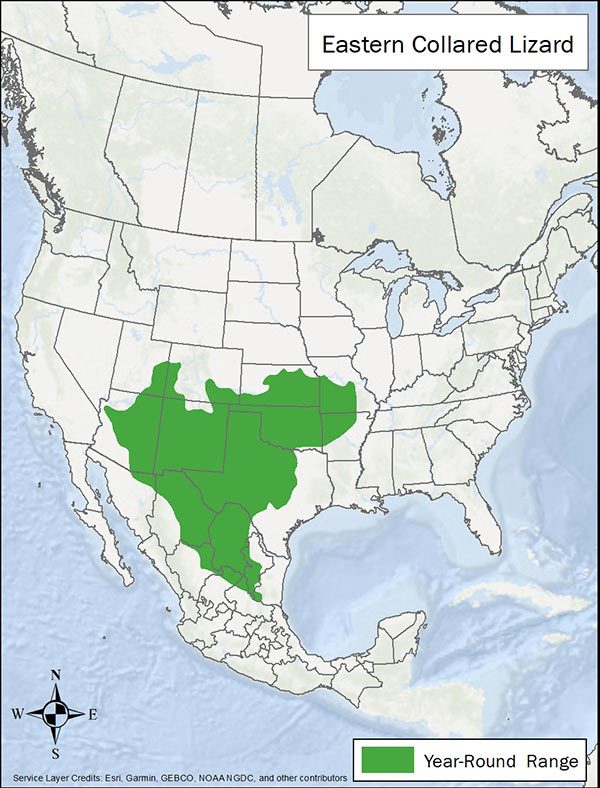LandPKS Learning
Habitat Hub

Eastern Collared Lizard
Eastern collared lizards are very alert—and very fast! They’re well adapted to running around their rocky habitats and jump among rocks easily. At top speeds, they run using only their back legs! They have highly powerful jaws capable of delivering a strong bite that can break the skin if captured.
Crotaphytus collaris
Identification
The eastern collared lizard is a colorful lizard also known as a mountain boomer. It is relatively large, 8-12 in/20-30 cm long, including the very long tail, twice the length of the body. Their heads are large compared to the rest of their body. Eastern collared lizards are known for a pair of black stripes, or collars, one thicker than the other, around their neck. The body of the male collared lizard is blue-green or green with bright orange and/or yellow spots or bands on the throat, face, and back, and a white belly (see photo). Females have more dull coloration.
Observation Tips
The eastern collared lizard range is from southeastern Utah and Arizona in the west, south-central Missouri and Arkansas to the east, and Mexico to the south. Populations in Louisiana may be introduced. Many populations exist in protected areas. Eastern collared lizards are active during the daytime. They can be seen basking on rocks, though they often hide under rocks or in crevices. Males are most vibrant and active during the mating season, which is in May and June. Females lay 4-11 eggs 1-2 times per year under rocks or in burrows between May and July, depending on the region. Eastern collared lizards are inactive (in a type of light hibernation) under rocks or in burrows from October or November to March or April.
Interesting Fact
Eastern collared lizards are very alert—and very fast! They’re well adapted to running around their rocky habitats and jump among rocks easily. At top speeds, they run using only their back legs! They have highly powerful jaws capable of delivering a strong bite that can break the skin if captured.
Ideal Habitat
Ideal Eastern collared lizard habitat is rocky areas (>20% rock cover) with sparse vegetation, including open woodlands, canyons, gullies, slopes, and mesa tops. They can also be found in abandoned rock quarries. Rock lookout perches taller than surrounding areas are necessary so the lizard can scan for predators and prey.

Range map provided by International Union for Conservation of Nature
Management Activities that Benefit Species – Best Management Practices (BMPs)
Maintain open areas of natural vegetation with rocky outcrops to support visibility for eastern collared lizards. Controlled burns can help maintain sparse vegetation and slow the growth of trees, including cedars, in their habitat.
Management Activities to Avoid
Eastern collared lizards are threatened by habitat loss and degradation. Avoid fire suppression activities, which can result in an overgrowth of trees in their habitat. Another threat is the collection for the pet trade. Few wild-captured eastern collared lizards can survive in captivity. Avoid capturing them or allowing others to capture them on private property.
Other Species that Benefit from Similar Habitat Management
Eastern collared lizards eat almost anything they can fit in their mouths, including various species that may be considered pests to people, such as insects and spiders. They are also prey for other species, such as snakes, hawks, and roadrunners.
Download
Download the Eastern Collared Lizard factsheet
Other Resources
Herps of Arkansas. 2007. Eastern collared lizard.
International Union for Conservation of Nature (IUCN). 2007. The IUCN Red List of Threatened Species. Version 2021-1. Crotaphytus collaris.
Missouri Department of Conservation. Eastern collared lizard.
NatureServe. 2021. NatureServe Explorer: An online encyclopedia of life [web application]. Version 7.1. NatureServe, Arlington, Virginia. Eastern collared lizard.
Oklahoma Department of Wildlife Conservation. 2021. Field Guide. Eastern collared lizard.
Photo credit: Peter Paplanus/Flickr
Mobile App | Data Portal | Knowledge Hub | Habitat Hub | Learning Collections | Blog | About | Contact | Support



